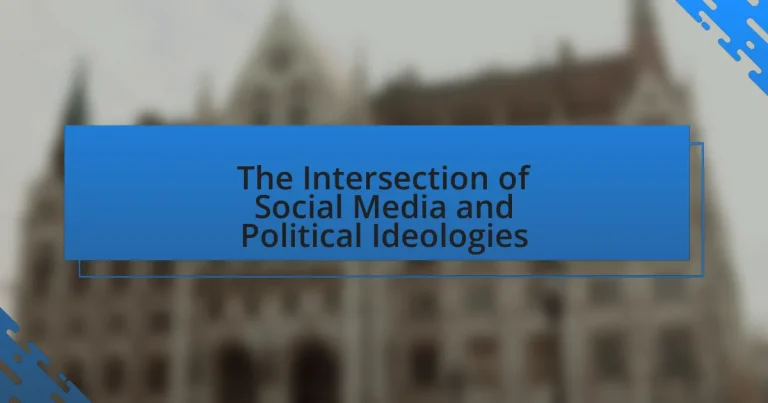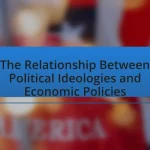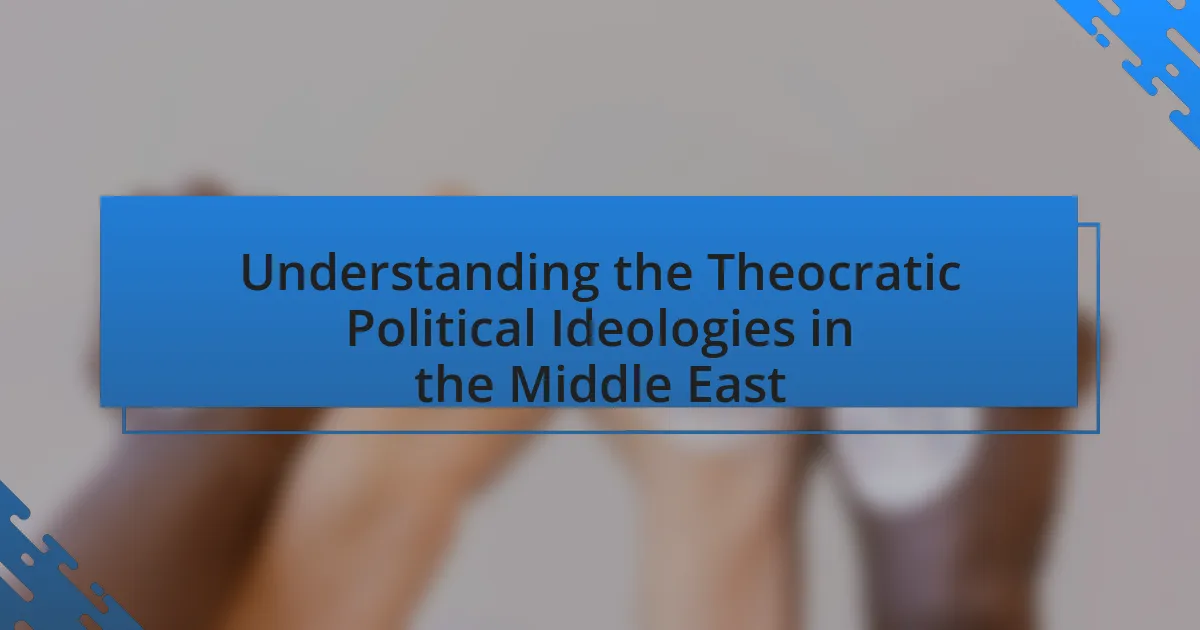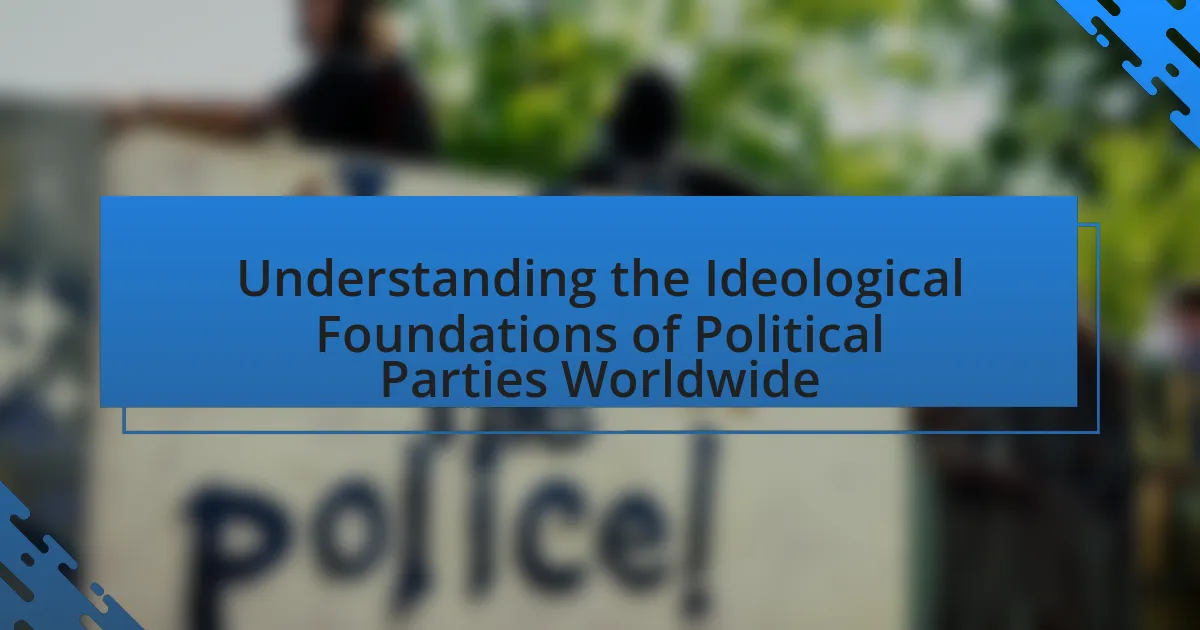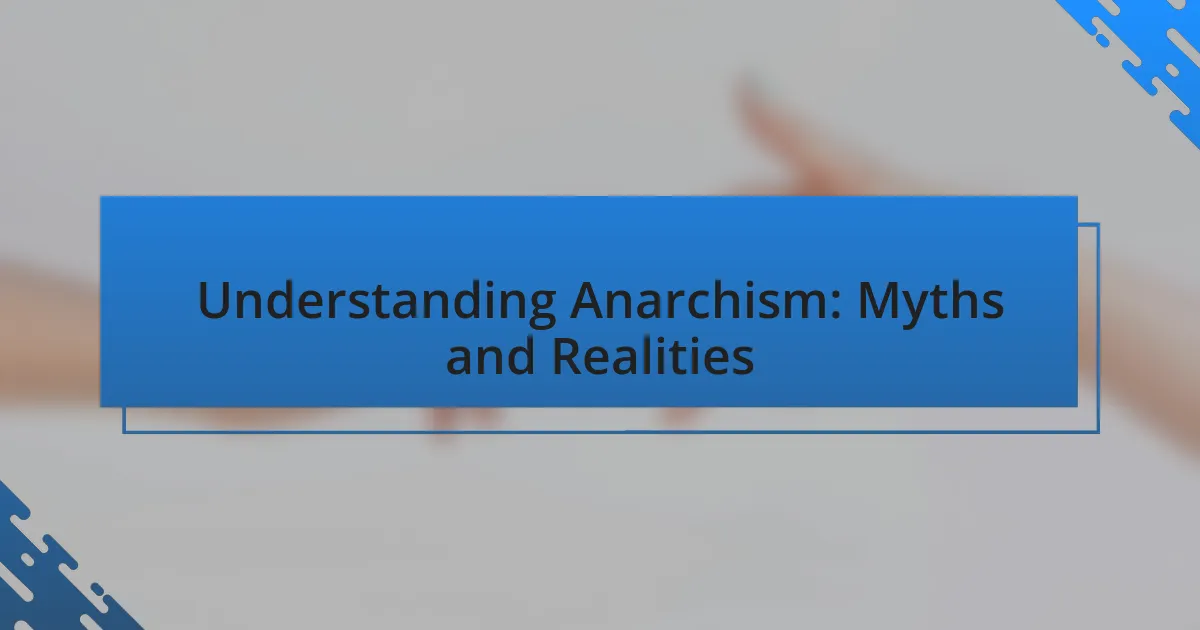The intersection of social media and political ideologies examines how social media platforms facilitate the spread and reinforcement of diverse political beliefs, often leading to echo chambers that amplify polarization. Approximately 62% of Americans rely on social media for news, significantly influencing public opinion and political discourse. Algorithms play a crucial role in shaping this landscape by prioritizing engaging content, which can distort perceptions and deepen ideological divides. The article explores the implications of these dynamics for democracy, civic engagement, and the challenges posed by misinformation, while also highlighting the strategies employed by various political ideologies to leverage social media for activism and mobilization.
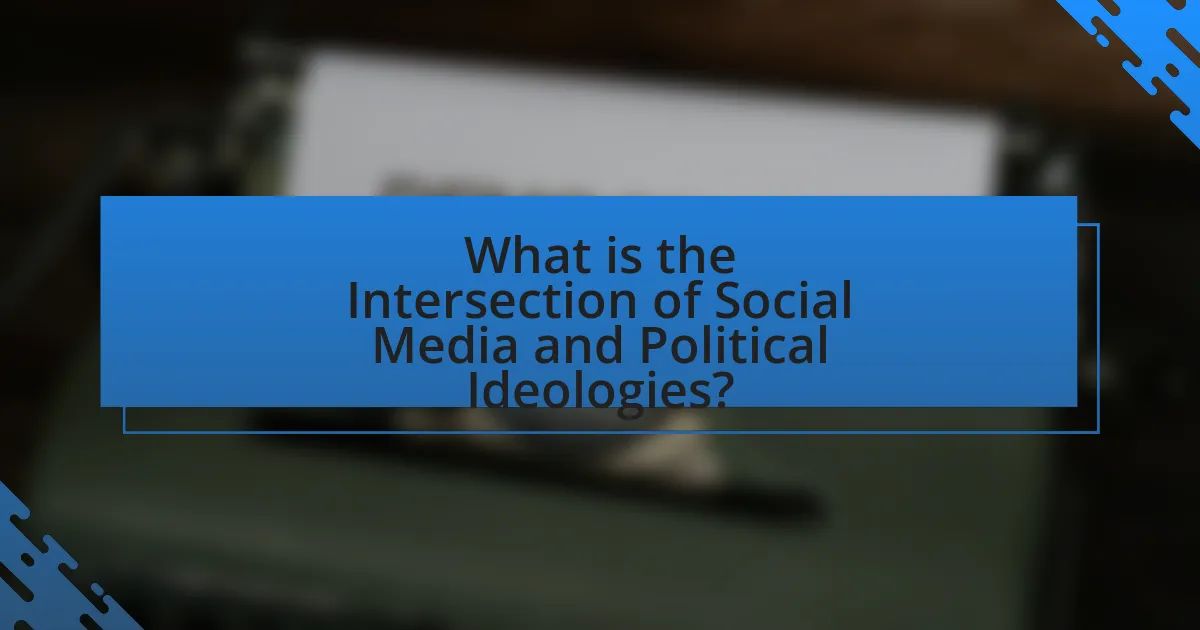
What is the Intersection of Social Media and Political Ideologies?
The intersection of social media and political ideologies is characterized by the way social media platforms facilitate the dissemination and reinforcement of diverse political beliefs. Social media enables users to share, discuss, and promote their political ideologies, often leading to the formation of echo chambers where individuals are exposed primarily to viewpoints that align with their own. Research indicates that approximately 62% of Americans get their news from social media, which significantly influences public opinion and political polarization. This dynamic can amplify extreme ideologies, as algorithms prioritize content that generates engagement, often favoring sensational or divisive material.
How do social media platforms influence political ideologies?
Social media platforms influence political ideologies by facilitating the rapid dissemination of information and enabling targeted communication among users. These platforms allow individuals to share opinions, engage in discussions, and mobilize support for various political causes, which can shape public perception and ideological alignment. For instance, research by the Pew Research Center indicates that 64% of Americans believe social media has a significant impact on their political views, highlighting the platforms’ role in shaping political discourse. Additionally, algorithms that curate content based on user preferences can create echo chambers, reinforcing existing beliefs and polarizing political ideologies.
What role do algorithms play in shaping political discourse on social media?
Algorithms play a crucial role in shaping political discourse on social media by determining the visibility and reach of content based on user engagement metrics. These algorithms prioritize posts that generate higher interactions, such as likes, shares, and comments, which can amplify certain political viewpoints while marginalizing others. For instance, research by the Pew Research Center indicates that algorithm-driven content curation can lead to echo chambers, where users are predominantly exposed to information that aligns with their existing beliefs, thereby reinforcing political polarization. This selective exposure influences public opinion and discourse by creating a feedback loop that favors sensational or emotionally charged content, often at the expense of nuanced discussions.
How does user engagement affect the spread of political ideologies?
User engagement significantly accelerates the spread of political ideologies by amplifying content visibility and fostering community interactions. When users actively like, share, or comment on political posts, they increase the likelihood that these ideologies reach a broader audience through algorithms that prioritize engaging content. For instance, a study by the Pew Research Center found that 64% of Americans believe social media has a significant impact on political discourse, highlighting how user interactions can shape public opinion and mobilize support for specific ideologies. Additionally, platforms like Facebook and Twitter facilitate echo chambers, where engaged users reinforce their beliefs and influence others, further propagating particular political narratives.
Why is understanding this intersection important?
Understanding the intersection of social media and political ideologies is crucial because it shapes public opinion and influences democratic processes. Social media platforms serve as primary channels for political discourse, allowing ideologies to spread rapidly and reach diverse audiences. Research indicates that 62% of adults obtain news from social media, highlighting its role in shaping perceptions and political engagement. Furthermore, algorithms on these platforms can create echo chambers, reinforcing existing beliefs and polarizing communities. This dynamic underscores the importance of critically analyzing how social media impacts political ideologies and the implications for societal cohesion and democratic integrity.
What implications does this have for democracy and civic engagement?
The implications of social media on democracy and civic engagement are significant, as it can both enhance and undermine democratic processes. Social media platforms facilitate greater access to information and enable diverse voices to participate in political discourse, which can lead to increased civic engagement and voter mobilization. For instance, studies have shown that social media campaigns can effectively increase voter turnout, particularly among younger demographics. However, social media also poses risks, such as the spread of misinformation and the creation of echo chambers, which can polarize public opinion and diminish the quality of democratic debate. Research by the Pew Research Center indicates that 64% of Americans believe that misinformation has a major impact on their ability to make informed decisions. Thus, while social media can empower civic engagement, it also presents challenges that can threaten the integrity of democratic processes.
How can it affect public opinion and political polarization?
Social media significantly affects public opinion and political polarization by amplifying echo chambers and facilitating the spread of misinformation. Research indicates that individuals are more likely to engage with content that aligns with their pre-existing beliefs, leading to increased polarization. A study by the Pew Research Center found that 62% of Americans believe social media platforms have a negative impact on the way people think about political issues, contributing to divisive narratives. Furthermore, algorithms prioritize sensational content, which can distort perceptions and deepen ideological divides, as evidenced by the rise in extreme political rhetoric online.
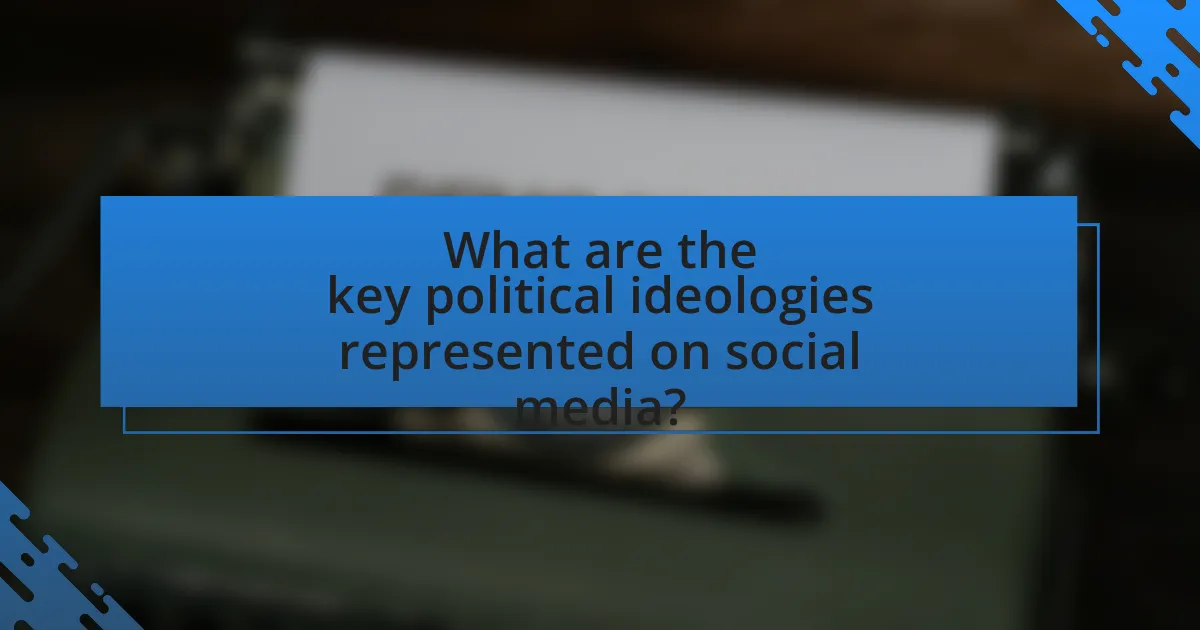
What are the key political ideologies represented on social media?
Key political ideologies represented on social media include liberalism, conservatism, socialism, nationalism, and libertarianism. These ideologies manifest through various online communities, discussions, and content sharing, influencing public opinion and political discourse. For instance, liberalism often promotes social justice and equality, while conservatism emphasizes tradition and limited government intervention. Socialism advocates for collective ownership and economic equality, nationalism focuses on national sovereignty and identity, and libertarianism champions individual freedom and minimal state control. The prevalence of these ideologies on platforms like Twitter, Facebook, and Instagram shapes political engagement and mobilization, as evidenced by the significant role social media played in movements such as the Arab Spring and Black Lives Matter.
How do different political ideologies utilize social media?
Different political ideologies utilize social media to promote their messages, engage with supporters, and mobilize action. For instance, left-leaning groups often leverage platforms like Twitter and Facebook to advocate for social justice issues, utilizing hashtags to create viral movements, as seen with the #BlackLivesMatter campaign. Conversely, right-leaning ideologies may focus on platforms like Parler or Gab to foster communities that align with their values, often emphasizing free speech and opposing perceived censorship from mainstream platforms. Research indicates that political polarization is exacerbated by social media algorithms that favor content aligning with users’ existing beliefs, further entrenching ideological divides.
What strategies do conservative groups employ on social media?
Conservative groups employ targeted messaging, grassroots mobilization, and the use of influencers on social media to effectively engage their audience. Targeted messaging involves crafting specific narratives that resonate with conservative values, often utilizing data analytics to identify and reach key demographics. Grassroots mobilization is facilitated through platforms like Facebook and Twitter, where these groups encourage followers to share content, participate in discussions, and organize events, thereby amplifying their reach. Additionally, conservative groups often collaborate with social media influencers who align with their ideologies to promote their messages, leveraging the influencers’ established audiences for greater impact. These strategies have been shown to enhance engagement and mobilization, as evidenced by the significant online presence and activity of conservative movements during electoral campaigns.
How do progressive movements leverage social media for activism?
Progressive movements leverage social media for activism by utilizing platforms to mobilize supporters, disseminate information, and create awareness about social issues. These movements often employ targeted campaigns that engage users through hashtags, viral content, and community-building initiatives, which enhance visibility and foster collective action. For instance, the #BlackLivesMatter movement effectively used Twitter and Instagram to raise awareness about racial injustice, leading to widespread protests and policy discussions. Research indicates that social media can amplify marginalized voices, with a study by the Pew Research Center showing that 69% of adults in the U.S. use social media, making it a powerful tool for reaching diverse audiences and driving social change.
What are the characteristics of political discourse on social media?
Political discourse on social media is characterized by its immediacy, accessibility, and interactivity. This environment allows users to engage in real-time discussions, share diverse viewpoints, and mobilize support for political causes. The platform’s algorithms often amplify polarizing content, leading to echo chambers where users are exposed primarily to opinions that reinforce their beliefs. Additionally, the brevity of posts encourages concise messaging, often resulting in oversimplification of complex issues. Research indicates that social media can significantly influence public opinion and political behavior, as evidenced by the role of platforms in recent elections and movements, such as the Arab Spring and the 2016 U.S. presidential election.
How does the tone of political communication vary across platforms?
The tone of political communication varies significantly across platforms, influenced by the audience, format, and nature of the platform. For instance, Twitter often features a more informal and concise tone due to character limits, encouraging quick, punchy statements and hashtags, while Facebook allows for longer, more detailed posts that can foster in-depth discussions. Research by the Pew Research Center indicates that 64% of Americans believe social media has a significant impact on political discourse, highlighting the platform’s role in shaping tone. Additionally, platforms like LinkedIn maintain a professional tone, focusing on policy discussions and professional networking, contrasting with the more emotive and sensational tone often found on platforms like TikTok, where visual storytelling and entertainment are prioritized.
What types of content are most effective in conveying political messages?
Visual content, such as infographics and videos, is most effective in conveying political messages. Research indicates that visual elements enhance engagement and retention of information, making complex political issues more accessible. For instance, a study by the Pew Research Center found that social media posts with images receive 94% more views than those without, demonstrating the power of visuals in capturing audience attention. Additionally, emotionally charged content, including personal stories and testimonials, resonates strongly with audiences, fostering empathy and connection to political issues. This combination of visual appeal and emotional engagement significantly amplifies the impact of political messaging on social media platforms.
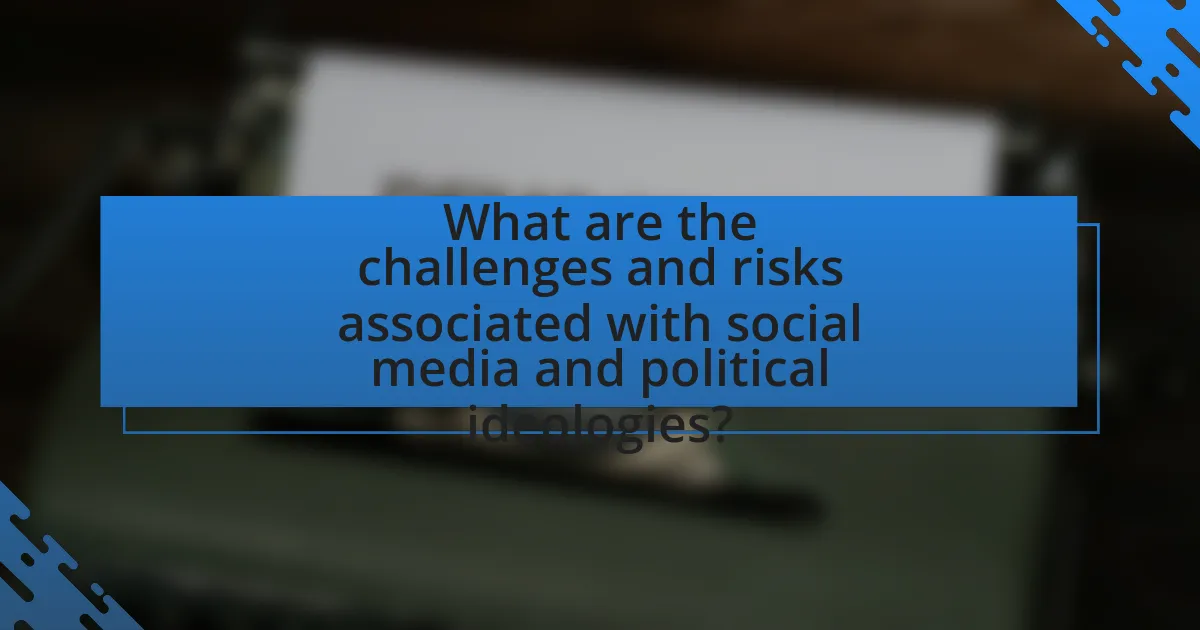
What are the challenges and risks associated with social media and political ideologies?
Social media presents significant challenges and risks related to political ideologies, primarily through the spread of misinformation, polarization, and echo chambers. Misinformation can rapidly circulate on platforms, leading to the distortion of facts and manipulation of public opinion, as evidenced by studies showing that false news spreads six times faster than true news on Twitter. Polarization occurs as users engage primarily with like-minded individuals, reinforcing their beliefs and creating divisions, which research from the Pew Research Center indicates has increased political hostility among users. Additionally, echo chambers limit exposure to diverse viewpoints, further entrenching ideological divides, as highlighted by a study from the University of California, Berkeley, which found that social media algorithms often prioritize content that aligns with users’ existing beliefs. These factors collectively contribute to a fragmented political landscape, undermining democratic discourse and increasing societal tensions.
How does misinformation impact political ideologies on social media?
Misinformation significantly influences political ideologies on social media by shaping perceptions and reinforcing biases. Research indicates that exposure to false information can lead individuals to adopt more extreme political views, as misinformation often aligns with pre-existing beliefs, creating echo chambers. A study published in the journal “Science” by Vosoughi, Roy, and Aral in 2018 found that false news spreads more rapidly on social media than true news, highlighting the susceptibility of users to misleading narratives. This dynamic fosters polarization, as individuals increasingly identify with ideologies that are amplified by misinformation, ultimately affecting political discourse and behavior.
What are the consequences of fake news on public perception?
Fake news significantly distorts public perception by spreading misinformation that influences beliefs and behaviors. Research indicates that exposure to false information can lead to increased polarization, as individuals may adopt extreme views based on misleading narratives. For instance, a study published in the journal “Science” found that false news stories are 70% more likely to be retweeted than true stories, demonstrating how misinformation can rapidly shape public opinion. Additionally, fake news can erode trust in legitimate media sources, leading to a general skepticism towards factual reporting. This erosion of trust further complicates the public’s ability to discern credible information, ultimately impacting democratic processes and societal cohesion.
How can users identify and combat misinformation?
Users can identify and combat misinformation by critically evaluating sources, verifying facts, and promoting media literacy. Critical evaluation involves checking the credibility of the source, such as its reputation and expertise in the subject matter. Verifying facts can be done through fact-checking websites like Snopes or FactCheck.org, which provide evidence-based assessments of claims. Promoting media literacy includes educating oneself and others about recognizing biases, understanding the context of information, and analyzing the intent behind messages. Research indicates that individuals who engage in these practices are less likely to fall victim to misinformation, as highlighted in studies by the Pew Research Center, which found that media literacy significantly enhances users’ ability to discern credible information.
What are the ethical considerations in the intersection of social media and political ideologies?
The ethical considerations in the intersection of social media and political ideologies include issues of misinformation, echo chambers, and the manipulation of public opinion. Misinformation can spread rapidly on social media platforms, leading to distorted perceptions of political realities, as evidenced by the 2016 U.S. presidential election, where false information significantly influenced voter behavior. Echo chambers occur when users are exposed primarily to viewpoints that reinforce their existing beliefs, limiting exposure to diverse perspectives and fostering polarization. Additionally, the manipulation of algorithms by social media companies can prioritize sensational content over factual reporting, further complicating the public’s ability to engage in informed political discourse. These ethical concerns highlight the responsibility of social media platforms to ensure transparency and accountability in their operations.
How do privacy concerns affect political engagement on social media?
Privacy concerns significantly reduce political engagement on social media by creating apprehension among users about sharing personal opinions and participating in discussions. Research indicates that individuals are less likely to express political views online when they fear surveillance or data misuse, as highlighted in a study by the Pew Research Center, which found that 64% of Americans feel their online activities are being monitored. This fear leads to self-censorship, where users avoid engaging in political discourse to protect their privacy, ultimately diminishing the diversity of political expression and participation on these platforms.
What responsibilities do social media companies have in moderating content?
Social media companies have the responsibility to moderate content to ensure user safety, prevent the spread of misinformation, and uphold community standards. This includes removing harmful content such as hate speech, harassment, and false information that can influence public opinion and political ideologies. For instance, platforms like Facebook and Twitter have implemented policies and algorithms to detect and remove such content, reflecting their obligation to create a safe online environment. According to a 2021 report by the Pew Research Center, 64% of Americans believe social media companies should take more responsibility for monitoring content, highlighting the public’s expectation for these companies to actively manage the information shared on their platforms.
What practical strategies can individuals use to navigate this intersection effectively?
Individuals can navigate the intersection of social media and political ideologies effectively by critically evaluating the sources of information they consume. This involves verifying the credibility of news outlets, cross-referencing facts with reputable sources, and being aware of potential biases in the content shared on social media platforms. Research indicates that individuals who engage in fact-checking and seek diverse perspectives are less likely to fall victim to misinformation, which is prevalent in politically charged environments. For instance, a study by the Pew Research Center found that users who actively seek out opposing viewpoints are more informed and better equipped to engage in constructive political discourse.
How can users critically evaluate political content on social media?
Users can critically evaluate political content on social media by verifying the credibility of sources, analyzing the context of the information, and recognizing biases. Verifying sources involves checking the reputation of the publisher and cross-referencing facts with reliable news outlets or academic studies. For example, a study by the Pew Research Center found that users who fact-check information are less likely to share false content. Analyzing context requires understanding the circumstances surrounding the information, including the date of publication and the intended audience. Recognizing biases involves identifying the political leanings of the content and the potential motivations behind it, as research indicates that partisan sources often present information in a way that aligns with their ideological stance.
What best practices should individuals follow to engage constructively in political discussions online?
Individuals should prioritize respectful communication and fact-based arguments to engage constructively in political discussions online. Respectful communication involves acknowledging differing viewpoints and refraining from personal attacks, which fosters a more open dialogue. Fact-based arguments require individuals to support their claims with credible sources, such as peer-reviewed studies or reputable news articles, ensuring that discussions are grounded in reality. For instance, a study published in the Journal of Communication found that respectful discourse significantly increases the likelihood of productive conversations, highlighting the importance of civility in online interactions.
